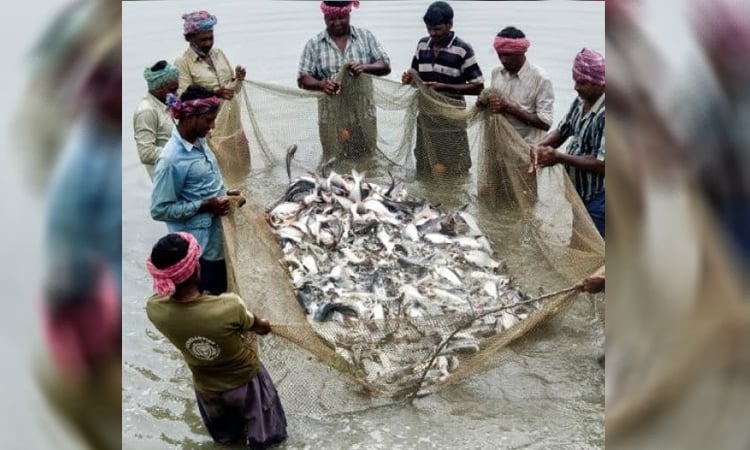News Flash
News Flash

By Md Aynal Haque
KHULNA, Jan 14, 2025 (BSS)- Since immemorial time, the Sundarbans, largest
mangrove forest in the world, is intricate with a network of tidal waterways,
mudflats and diverse flora and fauna.
The endowed natural resources play a crucial role in maintaining coastal
ecosystems and play a significant role in the ecosystem of Bangladesh.
Apart from this, the Sundarbans forms an ideal mangrove ecosystem, which
supports large groups of fish, shrimp, edible crab and also supplies food and
cash to local coastal communities.
However, the Sundarbans is under severe pressure and its protective function
is rapidly being undermined by poaching, illegal logging and other means of
unsustainable resource extraction.
Climate change and sea-level rise have negative impacts as well. High tides
are penetrating further inland each year causing top-dying of the Sundari
trees which are said to be intolerant to increased salinity.
Talking to BSS, Prof Anisul Haque of the Department of Fisheries and Marine
Sciences at Khulna University (KU) said the 6,017 square kilometres of
mangrove forest serves as a nursery ground for numerous fish and crustacean
species.
Hence, the forest is crucial to support the livelihood of the coastal
communities.
A large section of Sundarban's population is engaged in fisheries and allied
activities and fisheries are their sole livelihood.
Collecting prawn fish seeds from the rivers is one of the main sources of
earning among marginalized women and fisher folk. The fisher folk are using
mechanized as well as non-mechanized crafts.
The fishing gears are: trawl nets, purse seines, drift or gill nets, boat
seines, fixed bag nets, hooks and lines, shore seines, traps, scoop nets.
Referring to various research findings Prof Anisul Haque said the area is
home to a wide variety of flora and fauna, including critically endangered
species such as the Bengal Tiger and the Irrawaddy Dolphin.
The fishing resources of the Sundarbans are being destroyed due to free-style
fishing of shrimp in the free-style prohibited trawler nets in the Baleswar
River, sea estuary, and the Sundarban River.
Hundreds of people catch larvae using a specialized fishing net (locally
known as behundi jaal) from Patharghata of Barguna, Charduani, Padma and
Rajapur of Sarankhola, Sonatala, Khuriakhali villages and other areas of the
sea estuary and Kalamia Bharani of Sundarbans to the Shyala river estuary,
Katka, Dudhmukhi river estuary, Dublarchar, Dimerchar, Shukpara, Badamtala,
Chaprakhali and other rivers and estuaries of canals in the forest.
In Sundarbans mangrove, exploitation of major fish groups like white fish and
marketable shrimp has been reduced over the years whereas catch of Scylla
serrata shows an increasing trend.
The Penaeus monodon post larvae abundance was also declining. Any set of
management practices is almost non-existent in Sundarbans Reserve Forest,
resulting in serious over-exploitation of all the fish stocks and warrant
immediate attention.
Prof Mahmud Hossain of the Department of Forestry and Wood Technology at KU
said the less dense forest shows a slight decrease from one percent to 0.9
percent, indicating declining forest robustness and potential degradation due
to anthropogenic pressures or natural forest dynamics.
He said: "Conservation of the Sundarbans is crucial and requires a
multifaceted approach. This issue must be included in Loss and Damage
Funding, as it is a transboundary concern".
Due to indiscriminate fishing, there is a noticeable squeeze in biomass.
People catch local fish varieties, juvenile prawn, crabs and other molluscs
together, all in their eagerness to obtain the juvenile prawn.
Despite the increasing water body coverage, the 210 species of fish, shrimp,
crabs, Mollusca, and lobster, native to the region, is facing depletion due
to the widespread use of poisonous substances for fish baits.
Prof Hossain said the current threats and challenges faced by the Sundarbans
must also be considered, such as tiger population decline, Sundari tree
disappearance, Geographical Indication (GI) rights for 'Sundarbans honey',
and establishment of thermal coal plant and risky infrastructure.
He alleged that many researchers come to the Sundarbans, but do not
communicate their findings to policymakers. The actual loser is the fish
farmer, especially the small fish farmer, who stands to take the biggest hit
due to the dwindling fish catch."
Mihir Kumar Doe, conservator of Forests in Khulna, told BSS that there is
1,874 square-kilometer water area of the 6,017 square-kilometer Bangladesh
part of the Sundarbans, which is 31 percent of the total Sundarbans area.
In the Sundarbans aquatic area, there are 210 species of fishes, 24 species
of shrimps and 14 species of crabs.
On an average, more than one lakh local and foreign tourists visit the
Sundarbans every year, bringing revenue more than Taka one crore.
Sundarbans directly and indirectly support the livelihood of more than 10
lakh people as this mangrove forest protects coastal people from cyclones and
floods as a shield.